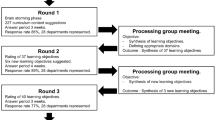Abstract
The University of Illinois purchased their first da Vinci System in September of 2002. Within the first calendar year, their program began orienting trainees to the da Vinci Standard System to make its inclusion in their clinical training run more smoothly. During the ensuring 16 years, their program has evolved into more frequent resident orientations, lectures, and courses. The program has grown over the course of different versions of the da Vinci System. Currently, their program houses three Xi and two Si systems. Led by Dr. Crawford and Mr. Dwyer they have formalized their curriculum using a systematic progression of skill acquisition. The lecture will detail the program’s organic development over the last 16 years. It will also explain the scientific measurement tools recently applied to the curriculum.
Similar content being viewed by others
References
Huettner F, Alley RA, Doubet JL, Ryan MJ, Dynda DI, Crawford DL (2012) Robotic foregut surgery: one surgeon’s experience with Nissen fundoplication, esophagomyotomy, and hiatal hernia repair. Surg Sci 3:1–9. https://doi.org/10.4236/ss.2012.31001
Huettner F, Dynda DI, Ryan MJ, Doubet JL, Crawford DL (2010) Robotic assisted minimally invasive surgery—a useful tool in resident training—the peoria experience 2002–2009. Int J Med Robot 6:386–393
Huettner F, Rawlings AL, McVay WB, Crawford DL (2008) Robot-assisted laparoscopic colectomy: 70 cases—one surgeon. J Robotic Surg 2(4):227–234
Pacheco P, Huettner F, Doubet JL, Ryan MJ, Dynda DI, Crawford DL (2011) 102 Consecutive robotic assisted minimally invasive colectomies—an outcome and technical update. J Gastrointest Surg 15:1195–1204
Rawlings A, Crawford D (2008) Telerobotic surgery for right and sigmoid colectomy. In: Bozovic V (ed) Medical robotics. Intech, Vienna (ISBN: 978-3-902613-18-9)
Tsoraides SS, Huettner F, Rawlings AL, Crawford DL (2010) Robotic Surgery of the Colon: The Peoria Experience. In: Baik SH (ed) Robotic surgery. Intech, Croatia (ISBN # 978-953-7619-77-0)
Rawlings AL, Woodland JH, Crawford DL (2006) Robotic colectomy: 30 consecutive cases. Surg Endosc 20(11):1713–1718
Rawlings AL, Woodland JK, Vagunta R, Gatta P, Crawford DL (2007) Robotic verses laparoscopic colectomy. Surg Endosc 21(10):1701–1708
Macgregor JM, Rebekah SK, Joseph G, Soliman MK, Andrea F, Kiyanda B, Rudolfo P, Carlos G (2016) Fundamentals of robotic surgery. Sages Org Sages, Los Angeles
Lee JY et al (2011) Best practices for robotic surgery training and credentialing. J Urol 185(4):1191–1197
Smith R, Patel V, Satava R (2014) Fundamentals of robotic surgery: a course of basic robotic surgery skills based upon a 14-society consensus template of outcomes measures and curriculum development. Int J Med Robot 10(3):379–384
Hung AJ et al (2013) Comparative assessment of three standardized robotic surgery training methods. BJU Int 112(6):864–871
Lallas CD, John W, Davis and Members of the Society of Urologic Robotic Surgeons (2012) Robotic surgery training with commercially available simulation systems in 2011: a current review and practice pattern survey from the society of urologic robotic surgeons. J Endourol 26(3):283–293
Narazaki K, Oleynikov D, Stergiou N (2006) Robotic surgery training and performance. Surg Endosc 20(1):96–103
Schreuder HW, Wolswijk R et al (2012) Training and learning robotic surgery, time for a more structured approach: a systematic review.”. BJOG Int J Obstet Gynaecol 119(2):137–149
Nolan HR, Christie MD, Ashley DW (2015) Comparison of attending and resident surgeons’ opinions of robotic surgery training in general surgery residency. Am Surg 81(8):E303
Murphy DG, Sundaram CP (2013) Comparative assessment of three standardized robotic surgery training methods. BJU Int 112(6):713–714
Fossati N et al (2015) 488 Factors influencing performance during robotic surgery training: results from the EAU robotic urology section HOT-program. Eur Urol Suppl 14(2):e488
Brinkman WM et al (2013) da Vinci skills simulator for assessing learning curve and criterion-based training of robotic basic skills. Urology 81(3):562–566
Stegemann AP et al (2013) Fundamental skills of robotic surgery: a multi-institutional randomized controlled trial for validation of a simulation-based curriculum. Urology 81(4):767–774
Goh AC et al (2012) Global evaluative assessment of robotic skills validation of a clinical assessment tool to measure robotic surgical skills. J Urol 187(1):247–252
Hart SG, Staveland LE (1988) Development of NASA-TLX (Task Load Index): results of empirical and theoretical research. Adv Psychol 52:139–183
Funding
No funding was obtained for this project.
Author information
Authors and Affiliations
Corresponding author
Ethics declarations
Conflict of interest
The authors declare that they have no conflict of interest.
Research involving human participants and/or animals
All procedures performed in studies involving human participants were in accordance with ethical standards of the institutional and/or national research committee and with the 1964 Helsinki declaration and its later amendments or comparable ethical standards.
Informed consent
For this type of study formal consent is not required.
Rights and permissions
About this article
Cite this article
Crawford, D.L., Dwyer, A.M. Evolution and literature review of robotic general surgery resident training 2002–2018. Updates Surg 70, 363–368 (2018). https://doi.org/10.1007/s13304-018-0573-x
Received:
Accepted:
Published:
Issue Date:
DOI: https://doi.org/10.1007/s13304-018-0573-x




